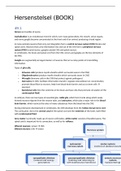Hersenstelsel (BOOK)
49.1
Nerves are bundles of axons.
Cephalization is an evolutionary trend in which, over many generations, the mouth, sense organs,
and nerve ganglia become concentrated at the front end of an animal, producing a head region.
In many animals neurons that carry out integration form a central nervous system (CNS) (brains and
spinal cord). Neurons that carry information into and out of the CNS form a peripheral nervous
system (PNS) (cranial nerves, ganglia outside CNS and spinal nerves).
In vertebrates, the brain and spinal cord from the CNS, nerves and ganglia are the key elements of
the PNS.
Ganglia are segmentally arranged clusters of neurons that act as relay points in transmitting
information.
Types of glia cells;
Schwann cells (produce myelin sheaths which surrounds axons in the PNS)
Oligodendrocytes (produce myelin sheaths which surrounds axons in CNS)
Microglia (immune cells in the CNS that protect against pathogens)
Astrocytes (in CNS; facilitate information transfer, regulate extracellular ion concentration,
promote blood flow to neurons, help form blood-brain barrier and act as stem cells
neurons)
Ependymal cells (line the ventricles in the brain and have cilia that promote circulation of the
cerebrospinal fluid)
In embryos, there are two types of essential glia; radial glia, which form tracks along which newly
formed neurons migrate from the neuron tube, and astrocytes, which play a major role in the blood-
brain barrier, which restricts the entry of many substances from the blood into the CNS.
During embryonic development in vertebrates, the CNS develops from the hollow dorsal nerve cord.
The cavity gives rise to the central canal of the spinal cord and the ventricles of the brain, both filled
with cerebrospinal fluid.
Grey matter is primarily made up of neuron cell bodies, white matter consists of bundled axons. The
spinal cord is important for its connection, as well as for reflexes.
Afferent neurons; sensor CNS
Efferent neurons; CNS motor Nervous system
autonomic motor system
nervous sytem (control of skeletal muscle
sympathetic division parasympathetic division enteric nervous
(arousal and energy (calming and returning to system
generation) self-maintanance functions) (spijsvertering)
, Parasympathetic nerves exit the CNS at the base of the brain or spinal cord, and form ganglia near or
within an internal organ. Sympathetic nerves exit the CNS midway along the spinal cord and form
synapses in ganglia located just outside the spinal cord.
In both divisions, the pathway for information involves preganglionic and postganglionic neurons.
Preganglionic neurons, have cell bodies in the CNS, and release acetylcholine as neurotransmitter.
Postganglionic neurons of the parasympathetic division release acetylcholine as well, whereas almost
all their counterparts in the sympathetic division release norepinephrine instead.
49.2
The vertebrate brain has three major regions;
forebrain (olfactory bulb and cerebrum)
o olfactory input smell
o regulation of sleep, learning, and complex processing
midbrain
o coordinates routing of sensory input
hindbrain (cerebellum)
o involuntary activities, blood circulation
o coordinates motor activities
The development of the human brain from embryo to child/adult.
telencephalon cerebrum
Forebrain
diencephalon diencephalon
midbrain mesencephalon midbrain
metencephalon pons, cerebellum
hindbrain
medulla
myelencephalon
oblongata
(voor functies, ligging, etc. zie notities HC)
The brainstem and cerebrum control arousal (state of alertness of the external world) and sleep.
During sleep external stimuli are received, but not consciously perceived.
Arousal and sleep are controlled in part by the reticular formation, a diffuse network formed
primarily by neurons in the midbrain and pons. Low-frequency waves characterises sleep, high-
frequency characterises wakefulness.





